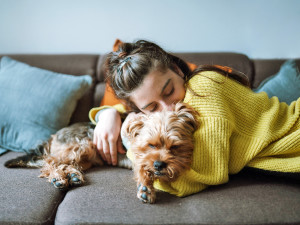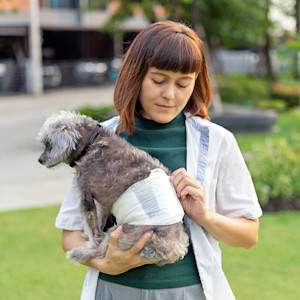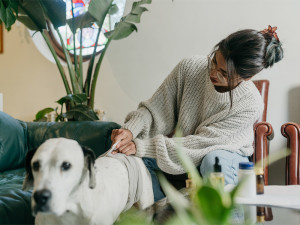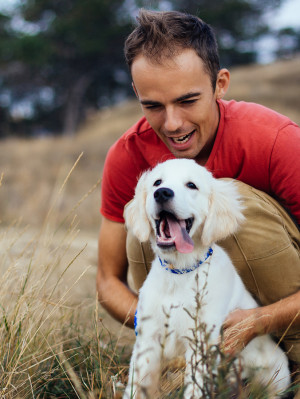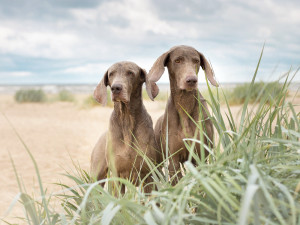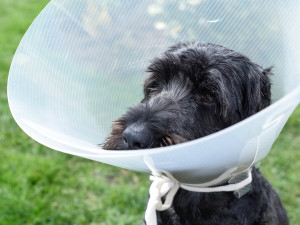Dogs in Heat: Signs, Stages, and Care Tips
Helpful tips to keep your dog safe and comfortable.
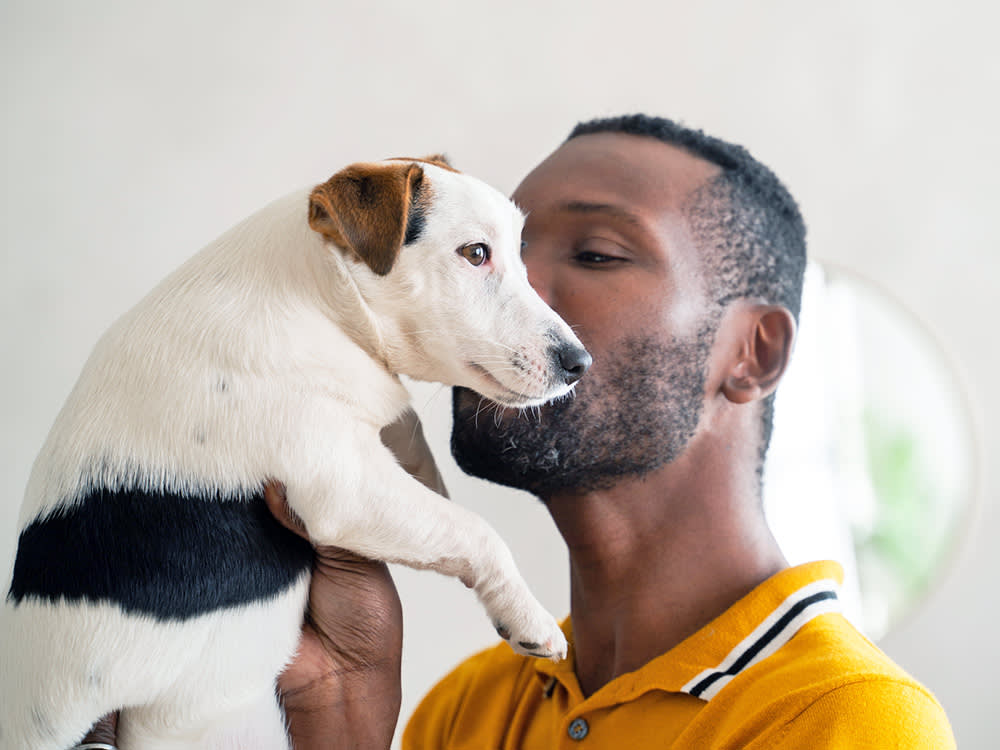
Share Article
In This Article:
Signs That Your Dog Is In Heat The Stages of a Dog’s Heat Cycle How to Care for Your Dog During Her Heat Cycle When to See a Vet: Red Flags to Watch For With a Dog in Heat
When your dog enters her heat cycle, she may not seem like herself; you may notice significant behavioral and physical changes that may be unfamiliar. Here, we’ll help sort out some of the confusion surrounding dogs in heat so you can easily understand the associated signs and how to better care for her.
Signs that your dog is in heat
Female dogs start their first heat cycle when they reach puberty, which for most is around six months old. Smaller breeds may start even earlier, and larger breeds may not reach puberty until closer to 18 months of age. This means puppyhood doesn’t last as long as most of us would like as a female can become pregnant at a very young age.
Because heat cycles may start at such a young age, you’ll need to be able to recognize the signs so that you can act accordingly to make sure your pup is cared for and doesn’t accidentally become pregnant. Look for signs, such as:

Physical signs
Swollen vulva
Vaginal discharge that goes from very bloody to thinner and pink in color
Frequent urination
Excessive licking of genitals
Behavioral signs
Restlessness
Clinginess
Aggressiveness towards other dogs
Decreased appetite
Nesting
Increased vocalization
The stages of a dog’s heat cycle
Depending on what stage of her heat cycle your dog is in, you may see different signs both behaviorally and physically.
Proestrus
This is when things are getting started. Under the influence of the hormone estrogen, your dog will have a swollen vulva and bloody discharge for roughly a week. During this time you may notice some males hanging around showing interest, and while she may play with them a bit, she won’t be fully receptive to breeding.
Estrus
If proestrus is when things are getting started, then estrus is when things really happen. A switch in influencing hormones from estrogen to progesterone will turn the bloody discharge more straw-colored, and she will become receptive to breeding. If you’re planning to breed your dog, here’s your chance. If not, this is when it’s most important to keep her securely away from males. Most dogs will remain in estrus for about a week, with some hanging in there for nearly 20 days.
Diestrus
Diestrus is a sort of holding period where progesterone continues to rise and then plateau whether a dog is pregnant or not. If she isn’t pregnant, you’ll see a decrease in vulvar swelling and she’ll return to her normal behaviors. Progesterone will slowly decrease after about 30 days and by 60 days will be back to its normal level. She won’t be receptive to males or showing any signs of heat.
If your dog is pregnant, diestrus will be her gestation period and she will start showing signs of pregnancy.
Anestrus
Anestrus is the time between heat cycles. It gives the reproductive system time to repair and refresh, especially if your dog had a litter of puppies. The length of this phase will differ between different dog breeds as smaller breeds tend to come into heat three times per year while large or giant breeds may only come in once. Medium to large breeds may fall somewhere in the middle and cycle twice per year.
How to care for your dog during her heat cycle
During your dog’s heat cycle, you’ll want to pay a little extra attention to her needs which may require a few accommodations.
Hygiene
Expect your pup to be a little messy for at least a week of her heat cycle. The bloody discharge that will often be your first clue that the seasons are changing for her can become a bit of a hygienic issue for your dog and your home. Consider doggie diapers that are secure and comfortable and that you can change frequently. Not only will these help with cleanliness, but they may also help with unwanted pregnancies.
Exercise and mental stimulation
Exercise and mental stimulation are still an important part of her routine, even if she may have other ideas in mind. You may want to change where or how you exercise her to avoid busy dog areas such as dog parks or heavily used trails.
As far as mental stimulation goes, reach for some favorite toys or at least unfamiliar ones that may pique her interest to deter her from trying to escape.
Health and comfort
Though her appetite may change a bit, continue to feed your dog her regular diet. If she doesn’t eat it all, that’s fine. Conversely, don’t feed her more just because she asks for it.
You can also provide her with a quiet, comfortable place. She may feel a little reclusive or she may become a little clingy. Either way, knowing she has a safe space may help as she works through some emotional changes.
Preventing unwanted pregnancy
If you never plan to breed your dog, the most effective way to prevent unwanted pregnancies is to have her spayed. Now, vets understand that there are a number of reasons why a female dog wouldn’t be spayed, including waiting until she’s older for larger breed pups.
Whatever the reason, if you don’t want to spay your dog but also don’t want her to become pregnant, you’ll need to be very vigilant during her heat cycles. Though the heat cycle may seem long, a female is only able to become pregnant during the estrus window which can last anywhere from three to even 21 days. During this time you’ll need to keep your dog securely confined without underestimating her or her potential mate’s hormonal power. A fenced-in yard typically isn’t enough; you’ll need to supervise her whenever she’s outside. Avoid other dog areas, and consider kenneling or gating throughout your home to keep her contained.
When to see a vet: red flags to watch for with a dog in heat
Dogs have been having heat cycles naturally for thousands of years. Our intervention typically isn’t necessary for things to go as planned. However, there are some instances when a little veterinary attention may be necessary.
Excessive bleeding
When we talked about vaginal discharge, we meant some bloody spotting most noticeable when your dog gets up from laying or sitting down, not outright gushing blood. There’s going to be some variation in the amount that a dog bleeds, but keep in mind that it shouldn’t be a significant amount and it shouldn’t cause lethargy or pale gums. If you feel that your dog is bleeding excessively while in heat, consult your veterinarian.
Infections
Generally, expect the color and smell of your dog’s discharge to be bloodier for a few days followed by a few days of lighter pink-colored. This will eventually turn to a yellowish brown after about a week. If your dog’s discharge is ever off-colored or has a foul odor or thicker texture, contact your vet as this could indicate an infection. Not eating, lethargy, and a fever are other signs that may come with it as well.
Behavioral changes
It’s perfectly normal for your dog’s behavior to be a little off during her cycle. She may become more clingy, more standoffish, and more aggressive towards other dogs. She may also pick up some pregnancy behaviors, such as nesting. However, it isn’t normal for these behaviors to go to the extreme. If she can’t stand to leave your side or acts like she never wants to see you again, or if her aggression goes to new levels, consult your vet.
After the heat cycle
Once your pup leaves proestrus and estrus behind, things should start to return to normal. Expect any vulvar swelling to subside, bleeding to stop, and her personality to level off. This can take a few weeks, so give her a little grace period, but see your vet if your dog continues to behave or look differently for more than three to four weeks following her heat cycle.
Dogs can go through what’s called a pseudo or false pregnancy when their body looks and feels pregnant. A dog experiencing a false pregnancy may experience belly swelling and may even start producing milk and mothering things around your home. Most of the time a false pregnancy will end when hormone levels return to normal, but some cases may require hormonal therapy, so see your vet if you’re at all concerned about your dog’s behavior.
References
Brooks, Wendy, DVM. “False Pregnancy in Dogs.” Veterinary Partner. 4 Jul 2023. https://veterinarypartner.vin.com/default.aspx?pid=19239&id=4952188opens in new tab.
“Dog Estrous Cycles.” Cornell Riney Canine Health Center. https://www.vet.cornell.edu/departments-centers-and-institutes/riney-canine-health-center/canine-health-information/dog-estrous-cyclesopens in new tab.

Dr. Chyrle Bonk, DVM
Dr. Chyrle Bonk has been a mixed-animal veterinarian since 2010, with a special interest in rehabilitation. When she's not practicing or writing about veterinary medicine, you may find her exploring the outdoors with her family or tending to her cows, horses, chickens, or cats and dogs.
Related articles
![Woman looking at pills for her dog at veterinary clinic.]()
Can I Give My Dog Pain Medication?
No, you should not give your dog over-the-counter pain medication for humans.
![Woman adjusting the diaper on her small black dog.]()
How to Get Your Dog to Wear a Diaper
And why they might need one.
![A woman putting a diaper on her dog in the living room.]()
5 Best Dog Diapers of 2023
The top diapers to combat excitable urination, leaking caused by incontinence, and accidents during potty training.
![Young Man With Retriever Puppy]()
When Should You Spay or Neuter Your Dog?
The research is confusing—here are some guidelines.
Male vs. Female Dogs: Are There Any Real Differences?
World-renowned behaviorist Patricia McConnell explains.
![black scruffy dog wearing cone recovering from spay surgery]()
Everything You Need to Know About Spaying and Neutering Your Dog
A vet’s take on why it’s a smart choice. Snip, snip!

